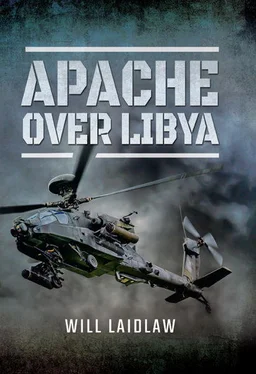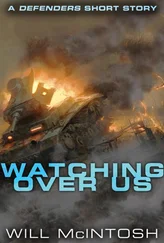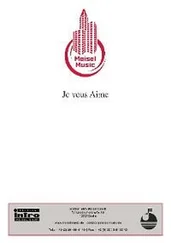‘Missile launch, 3 o’clock!… Flares! Flares! Flares!…
It’s coming at us…’
Libya, 9 June 2011
Rapid tension. Dry mouth. High voice. A new terror, searing fear. The possibility of being shot down over Libya by the most lethal Russian-made anti-helicopter weapon in existence was now a reality. Travelling at 800m per second, the missile was just three seconds from impact.
It was almost midnight and over the Libyan coast, not far from Misrata, two Apache attack helicopters raced in towards their target – a Command and Control node used by Khamis Gaddafi, the dictator’s favoured son. As soon as the pair crossed the coast an SA-24 heat-seeking missile was launched from the cover of the sand dunes. Even the most modern military helicopter should not be able to survive an SA-24 hit.
Again, ‘Flares! Flares! Flares!… Still coming at us…’
We had one second left in life. Everything was done, we had strained every sinew to survive, and now, in that last fragment of time, we stared in petrified astonishment as death raced at us. Then a chance was offered. The missile swerved, seduced by our final set of flares, and self-destructed in shards of bright white and orange shrapnel in front of my cockpit. I flinched and instinctively ducked at the explosion.
‘Whoa! That doesn’t give up does it’? I shouted to Staff Sergeant John Blackwell, my rear seat pilot.
Simultaneously, from the wing aircraft, ‘That’s not an RPG! Looks high end, I have the launch point, I can see the shooter, ready to suppress.’ This was Mark Hall, my wingman, weapons man, Operations Warrant Officer, general expert and now companion in a fight for our lives, coming over the inter-aircraft frequency.
John Blackwell, calm, hands on the controls, kept us heading for our target. His voice cut through the chaos: ‘Boss, you’re ten seconds from a good launch profile…’
Pressing the transmission switch with my left foot, I issued the new plan: ‘I have the C2 node, you have the missile firing point, back with you in 45 seconds!’
Only seconds from the firing on the C2 node the surface-to-air missile had interrupted, now I was determined to get the job done, while Mark Hall and his rear-seater, Charlie Tollbrooke, protected the flank. Within 30 seconds I had put two Hellfire missiles into the C2 node and observed a few seconds of panic on the ground, before John brought our Apache hard round to the right.
I transmitted to Mark Hall, ‘Targets destroyed, lining up on your right, observing your fall of shot…’, and we manoeuvred to serve as protection for him as he tipped in, his 30mm disgorging three 20-round bursts to deal with the SA-24 man. It was 9 June 2011, only our third mission into Libya; we had two more months of this.
Chapter 2
Forming the Team
Consider this: the aircraft is done in, no longer flyable; you are over the sea at night and just a second from going in. Now, ribs cracking on impact, face thrashed against the controls, teeth smashed and jaw broken, but you’re lucky, somehow the canopy was off before you went in and you are conscious. Flesh-ripping ingress of water tears off your flying helmet and fills your mouth. Without air, now submerged, you choke. Entombed in darkness, you are cold-shocked, gasping involuntarily, upside down. In the time it takes to read these words, time has almost run out. All you have left is three seconds to locate your harness and release, undo the three cables still attached to the flying helmet that is hanging off your head, find the hole where the canopy was and force your body, armour, ammunition and weapon through the gap. You could take out the short-term air supply bottle and get another breath, but that would waste time. You’ve only been under fifteen seconds. You get out. The sinking aircraft is now too deep, you are negatively buoyant. It’s too late. You try to swim up, but you can’t. You pull the toggle to inflate your lifejacket; the water pressure denies its function. You sink. You’re waiting to drown.
* * *
At the start of this enterprise there were four of us: me, Little Shippers, Big Shippers and Mark Hall. We needed six more pilots to fly the Apache at sea. It wasn’t a popular choice. The sea is a brutal place and survival there demands time and luck, neither of which are predictable or likely to be in your favour. Time is measured in seconds, luck controls how badly injured you are, how heavy the aircraft is, how cold the water is, the scores of things that could trap a limb in the cockpit, the chances of getting the doors off before hitting the water. Luck fills the space planning cannot.
The Apache helicopter was designed in the 1970s to replace the Bell AH-1 Cobra that had seen service in Vietnam. It is fundamentally a land-based helicopter. In the early days the boffins at Hughes played with a maritime design but found it was not required, so stuck to the land project. The original AH64 A model Apache saw its first United States Army service in 1986, two years after Hughes became part of McDonnell Douglas. Notable success in Panama and the first Gulf War followed. In the mid-1990s the British Ministry of Defence ran a commercial competition with the aim of procuring ninety-eight Attack Helicopters for the Army and Royal Navy. With an ever-decreasing Defence budget a compromise was reached, but not on the capability of the platform. Eventually, sixty-seven of the upgraded AH64 D model Apaches were purchased, all with the highly capable Longbow Fire Control Radar. We have even strapped two enormous Rolls Royce engines to the side to give them more power. Since 1997 the Boeing Company has been the firm behind the Apache. The UK procured the aircraft via Augusta Westland, and through this conduit we have the finest attack helicopter in the world. Back in the late ’90s there were not enough of these new and highly complex aircraft to spread across two Services, so the Army got the lot, with a promise to train one of its squadrons to fly at sea. The challenge from the start was that the Apache was not designed to operate at sea.
But the British way is to disregard convention and make things work. The earliest embarked trials were carried out in 2004 and 2005, and it fell to 656 Squadron to do the work. They did. The aircraft could land and take off safely; the engineering could be done; the base level concept was proved. Then along came the conflict in Afghanistan. The Squadron put the maritime work on the shelf and became the first British Apache squadron to deploy to Afghanistan, adding another operation to its tally. From 2006 everything the British Army did was about succeeding there. All our training was about Afghanistan, all our equipment was optimized for the arid, talcum sand environment and all our people were brought up to think counter-insurgency thoughts. Nobody could doubt the success of the aircraft. It had a phenomenal impact in support of British and Coalition forces in Helmand. This is where it earned its spurs; six squadrons with lineage in the Auster, Sioux, Scout, Gazelle and Lynx were now flying the Apache and rotating one after another through Operation Herrick, the British name for the military mission in Helmand.
The squadron has an extraordinary operational history. From the Second World War, where the only two recipients of the Distinguished Flying Cross and the Military Cross combined flew in 656, to Malaya, Borneo, Rhodesia, the Falklands, the Balkans and Afghanistan, the squadron has fought for soldiers alongside sailors and airmen for over seventy years. This squadron’s heritage comes not from it finding a niche or somehow being ‘the best’; nor is it held in higher regard than any other squadron. It is just because 656 was next on the list to go, and when it did go the squadron performed as any military team would – with determination, spirit and courage, whatever the task and whatever the threat. In the early 2000s the squadron found itself next on the list again and became the first British Army Apache squadron. In 2006, when the UK committed forces to Helmand Province in Afghanistan, the squadron deployed with them. Over the next three years 656 Squadron went there and came back three times, returning for the last time in May 2009. I took command the same month, expecting to deploy with the squadron again the following year.
Читать дальше












